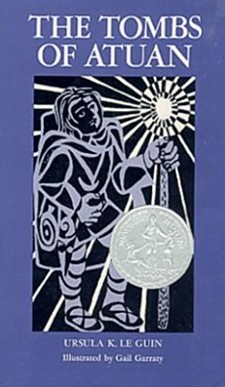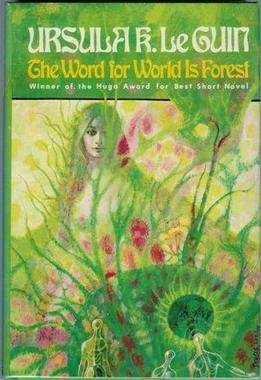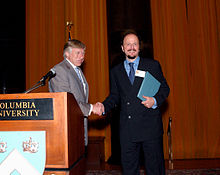Feminist science fiction is a subgenre of science fiction focused on such feminist themes as: gender inequality, sexuality, race, economics, reproduction, and environment. Feminist SF is political because of its tendency to critique the dominant culture. Some of the most notable feminist science fiction works have illustrated these themes using utopias to explore a society in which gender differences or gender power imbalances do not exist, or dystopias to explore worlds in which gender inequalities are intensified, thus asserting a need for feminist work to continue.
Science fiction and fantasy serve as important vehicles for feminist thought, particularly as bridges between theory and practice. No other genres so actively invite representations of the ultimate goals of feminism: worlds free of sexism, worlds in which women's contributions are recognized and valued, worlds that explore the diversity of women's desire and sexuality, and worlds that move beyond gender.

Ursula Kroeber Le Guin was an American author. She is best known for her works of speculative fiction, including science fiction works set in her Hainish universe, and the Earthsea fantasy series. Her work was first published in 1959, and her literary career spanned nearly sixty years, producing more than twenty novels and over a hundred short stories, in addition to poetry, literary criticism, translations, and children's books. Frequently described as an author of science fiction, Le Guin has also been called a "major voice in American Letters". Le Guin said she would prefer to be known as an "American novelist".

The Dispossessed is a 1974 anarchist utopian science fiction novel by American writer Ursula K. Le Guin, one of her seven Hainish Cycle novels. It is one of a small number of books to win all three Hugo, Locus and Nebula Awards for Best Novel. It achieved a degree of literary recognition unusual for science fiction due to its exploration of themes such as anarchism and revolutionary societies, capitalism, utopia, individualism, and collectivism.

The Tombs of Atuan is a fantasy novel by the American author Ursula K. Le Guin, first published in the Winter 1970 issue of Worlds of Fantasy, and published as a book by Atheneum Books in 1971. It is the second book in the Earthsea series after A Wizard of Earthsea (1969). The Tombs of Atuan was a Newbery Honor Book in 1972.

Jeffrey Kent Eugenides is an American author. He has written numerous short stories and essays, as well as three novels: The Virgin Suicides (1993), Middlesex (2002), and The Marriage Plot (2011). The Virgin Suicides served as the basis of the 1999 film of the same name, while Middlesex received the 2003 Pulitzer Prize for Fiction in addition to being a finalist for the National Book Critics Circle Award, the International Dublin Literary Award, and France's Prix Médicis.

Middlesex is a Pulitzer Prize–winning novel by Jeffrey Eugenides published in 2002. The book is a bestseller, with more than four million copies sold since its publication. Its characters and events are loosely based on aspects of Eugenides' life and observations of his Greek heritage. It is not an autobiography; unlike the protagonist, Eugenides is not intersex. The author decided to write Middlesex after reading the 1980 memoir Herculine Barbin and finding himself dissatisfied with its discussion of intersex anatomy and emotions.

The Word for World Is Forest is a science fiction novel by American writer Ursula K. Le Guin, first published in the United States in 1972 as a part of the anthology Again, Dangerous Visions, and published as a separate book in 1976 by Berkley Books. It is part of Le Guin's Hainish Cycle.

The Telling is a 2000 science fiction novel by Ursula K. Le Guin set in her fictional universe of Hainish Cycle. The Telling is Le Guin's first follow-up novel set in the Hainish Cycle since her 1974 novel The Dispossessed. It tells the story of Sutty, a Terran sent to be an Ekumen observer, on the planet Aka, and her experiences of political and religious conflicts between a corporatist government and the indigenous resistance, which is centered on the traditions of storytelling, locally referred to as "the Telling".
Gender has been an important theme explored in speculative fiction. The genres that make up speculative fiction, science fiction, fantasy, supernatural fiction, horror, superhero fiction, science fantasy and related genres, have always offered the opportunity for writers to explore social conventions, including gender, gender roles, and beliefs about gender. Like all literary forms, the science fiction genre reflects the popular perceptions of the eras in which individual creators were writing; and those creators' responses to gender stereotypes and gender roles.

The Eye of the Heron is a 1978 science fiction novel by American author Ursula K. Le Guin which was first published in the science fiction anthology Millennial Women.

Feminist literature is fiction, nonfiction, drama, or poetry, which supports the feminist goals of defining, establishing, and defending equal civil, political, economic, and social rights for women. It often addresses the roles of women in society particularly as regarding status, privilege, and power – and generally portrays the consequences to women, men, families, communities, and societies as undesirable.
A novel is an extended work of narrative fiction usually written in prose and published as a book. The word derives from the Italian: novella for "new", "news", or "short story ", itself from the Latin: novella, a singular noun use of the neuter plural of novellus, diminutive of novus, meaning "new". According to Margaret Doody, the novel has "a continuous and comprehensive history of about two thousand years", with its origins in the Ancient Greek and Roman novel, Medieval Chivalric romance, and the tradition of the Italian Renaissance novella. The ancient romance form was revived by Romanticism, in the historical romances of Walter Scott and the Gothic novel. Some novelists, including Nathaniel Hawthorne, Herman Melville, Ann Radcliffe, and John Cowper Powys, preferred the term "romance". Such "romances" should not be confused with the genre fiction romance novel, which focuses on romantic love. M. H. Abrams and Walter Scott have argued that a novel is a fiction narrative that displays a realistic depiction of the state of a society, while the romance encompasses any fictitious narrative that emphasizes marvellous or uncommon incidents. Works of fiction that include marvellous or uncommon incidents are also commonly called novels, including Mary Shelley's Frankenstein, J. R. R. Tolkien's The Lord of the Rings, and Harper Lee's To Kill a Mockingbird.

The Left Hand of Darkness is a science fiction novel by the American writer Ursula K. Le Guin. Published in 1969, it became immensely popular, and established Le Guin's status as a major author of science fiction. The novel is set in the fictional Hainish universe as part of the Hainish Cycle, a series of novels and short stories by Le Guin, which she introduced in the 1964 short story "The Dowry of Angyar". It was fourth in sequence of writing among the Hainish novels, preceded by City of Illusions, and followed by The Word for World Is Forest.
The role of women in speculative fiction has changed a great deal since the early to mid-20th century. There are several aspects to women's roles, including their participation as authors of speculative fiction and their role in science fiction fandom. Regarding authorship, in 1948, 10–15% of science fiction writers were female. Women's role in speculative fiction has grown since then, and in 1999, women comprised 36% of the Science Fiction and Fantasy Writers of America's professional members. Frankenstein (1818) by Mary Shelley has been called the first science fiction novel, although women wrote utopian novels even before that, with Margaret Cavendish publishing the first in the seventeenth century. Early published fantasy was written by and for any gender. However, speculative fiction, with science fiction in particular, has traditionally been viewed as a male-oriented genre.
The anthropologist Leon E. Stover says of science fiction's relationship to anthropology: "Anthropological science fiction enjoys the philosophical luxury of providing answers to the question "What is man?" while anthropology the science is still learning how to frame it". The editors of a collection of anthropological SF stories observed:
Anthropology is the science of man. It tells the story from ape-man to spaceman, attempting to describe in detail all the epochs of this continuing history. Writers of fiction, and in particular science fiction, peer over the anthropologists' shoulders as the discoveries are made, then utilize the material in fictional works. Where the scientist must speculate reservedly from known fact and make a small leap into the unknown, the writer is free to soar high on the wings of fancy.

The Marriage Plot is a 2011 novel by American writer Jeffrey Eugenides. The novel grew out of a manuscript that Eugenides began after the publication of his Pulitizer Prize-winning novel, Middlesex. Eugenides has stated that he worked on the novel for about five or six years, and that portions are loosely based on his collegiate and post-collegiate experiences. The book is both a realist story about marriage and a commentary on the kind of story it tells.
"The Matter of Seggri" is a science fiction novelette by American writer Ursula K. Le Guin. It was first published in 1994 in the third issue of Crank!, a science fiction – fantasy anthology, and has since been printed in number of other publications. In 2002, it was published in Le Guin's collection of short stories The Birthday of the World: and Other Stories. "The Matter of Seggri" won the Otherwise Award in 1994 for exploring "gender-bending" and has been nominated for other honors including the Nebula Award.
Earthsea is a fictional world created by American writer Ursula K. Le Guin. Introduced in her short story "The Word of Unbinding", published in 1964, Earthsea became the setting for a further six books, beginning with A Wizard of Earthsea, first published in 1968, and continuing with The Tombs of Atuan, The Farthest Shore, Tehanu, Tales from Earthsea and The Other Wind. Nine short stories by Le Guin are also set in Earthsea; the earliest two in her 1975 collection of short stories The Wind's Twelve Quarters, five in Tales from Earthsea, and the final two in an illustrated collection in The Books of Earthsea. Collectively, the series is simply known as Earthsea.

Intersex people and themes appear in numerous books, comics and magazines. Intersex, in humans and other animals, describes variations in sex characteristics including chromosomes, gonads, sex hormones, or genitals that, according to the UN Office of the High Commissioner for Human Rights, "do not fit typical binary notions of male or female bodies". Morgan Holmes describes common representations of intersex people as monsters or ciphers for discussions about sex and gender, while Phoebe Hart contrasts a small number of examples of well-rounded characters with the creation of "objects of ridicule".

"Coming of Age in Karhide" is a science fiction short story by Ursula K. Le Guin, first published in 1995. The story is set on the fictional planet of Gethen, the same as Le Guin's 1969 novel The Left Hand of Darkness, and is a part of Le Guin's Hainish cycle. The story explores themes of growing into adulthood on a planet where individuals have no fixed gender identity. Reviewers stated that the story went further than Left Hand in its exploration of gender and sexuality, and was a "quietly feminist" work. It was also described as lacking the "dizzying impact" of Left Hand. In 2002, it was anthologized in the volume The Birthday of the World, along with many other stories exploring marriage and sexual relationships.
















